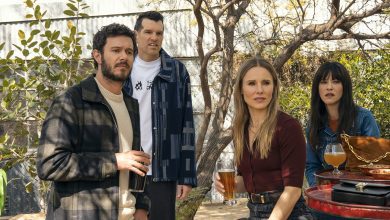Exploring the Impact of Season 3 Deaths on an Unforgettable Finale: A Deep Dive into the Revelations

[This story contains major spoilers from the penultimate episode of season three of Yellowjackets, “How the Story Ends.”]
Yellowjackets season three has not been for the faint of heart. This season of the hit Showtime series went on a killing spree, both out in the wilderness during the 1996 timeline, as well as in present day with the adult survivors of a plane crash that stranded them for 19 months when they were teenagers.
اRelated Posts:
The most unexpected deaths came in episode four, when Simone Kessell‘s Adult Lottie was mysteriously found dead at the bottom of a familiar looking staircase (seen in a vision by Lottie in season one), and in the penultimate episode when Lauren Ambrose‘s Van was fatally stabbed in the heart by Adult Melissa (played by guest star Hilary Swank). The finale, which is titled “Full Circle” (written by Ameni Rozsa and directed by co-creator Bart Nickerson), will deliver the long-awaited answer around who killed Lottie Matthews, and viewers will see how the remaining core adult cast picks up the pieces after Van’s death.
The penultimate episode also brought a brutal death to wilderness guide Kodiak, who was played by guest star Joel McHale. In another surprising move, his traveling companion Hanna (Ashley Sutton) plunged a knife into his eye shortly after he called Hanna the C-word for turning on him. When speaking to McHale about the way he goes out, McHale tells The Hollywood Reporter, “He’s not the nicest person on the planet, so he’s really asking for it when he says that, and he gets it. That was the last take [I filmed], and I only did that once. Other insults were in there, but we were like, ‘What could really make this guy unlikable?’” He adds, “I do know what they do with my body.”
In another twist, Adult Melissa not only survives her confrontation with her former teammates, but she also escapes after killing Van. Swank, when speaking to THR, says she thinks Melissa isn’t operating under any sort of plan. “I think she’s going minute by minute, because she wasn’t planning on doing that [killing Van],” she says. “I don’t think that she has thought about what happens next.”
Ben Semanoff, who directed episode nine’s “How the Story Ends,” returned to the Yellowjackets fold to direct this pivotal hour in the season after directing two earlier key episodes: “Edible Complex,” the iconic season two episode that featured the cannibalistic feast of dead teammate Jackie (Ella Purnell), and shortly after, “Two Truths and a Lie,” which was Ambrose’s true debut as Van.
Below, the director speaks to THR about that full circle experience directing Ambrose as Adult Van as he shares many elements of the packed penultimate episode that the audience likely missed, including around Van’s tragic death, the significance of that pit and what he thinks are Hanna’s real intentions as the teenagers get more feral and savage out in the wilderness. All of this, he says (and like co-creators Nickerson and Ashley Lyle had promised from the start), is leading to a revelatory finale.
***
Van’s death has left us all very sad. You’ve directed some huge Yellowjackets episodes: last season’s “The Edible Complex” — when they ate Jackie! — “Two Truths and a Lie” and now this.
Van is a universally loved character, so everybody seems to be having a similar sentiment. The significant thing with “Two Truths and a Lie” is that was the first time that Lauren Ambrose really appeared as Van. She was in one shot in the previous episode, but then her real debut was in my episode. It was a unique experience for me in the guest directing role, getting an opportunity to craft a character: What is Van like today, after 20 years of life? So that was great, I enjoyed it. Lauren and I got along great. Then when I came back for this episode, we commiserated about how it was an interesting alpha-omega to our relationship on the show.
That is very full circle that you brought Van in, and now you’ve brought her out. Her death episode opened with a dream sequence that foreshadowed everything, if you knew where it was going. What was it like filming with both Lauren and Liv Hewson (who plays Teen Van), and how much did you want to hint about what was going to happen?
Creators Bart Nickerson and Ashley Lyle are terrific and Jonathan Lisco is such a great showrunner. They really put a lot of trust in me. I’ve had these great opportunities several times where they’ve presented me with something new to the show and said, “Go figure out what this will look and feel like.” A good example was the Jackie feast. They had written it in a certain way, where it was maybe a little bit more of a barbaric version and I said, “I feel like they need to be in these Grecian gowns.” Here was another example, because one of the characters was speaking with themselves. Shauna speaks with Jackie all the time, but this was sort of a new metaphysical space for the show.
Bart came up to me and said, “I cannot wait to see what you do with this. This is why we want you on this episode.” But of course, that puts a lot of pressure trying to figure out what a conversation with yourself in a hospital where you’re bordering on death is going to look like. It was a really fun exploratory experience from a cinematic and a storytelling standpoint, as well as in the edit. What are things that might actually occur if you were having a conversation with yourself? Maybe she sees herself but we don’t see her talking. We see Teen Van without words, but she hears thoughts, like interesting metaphysical space stuff. And in terms of The Goonies references, that was a beautiful little nugget in the script and a theme we got to play with. Movies from that era are sort of the fabric of my family, so it was really beautiful to weave a little bit of that into the episode and send Van off on this treasure hunt.
Van has been living on borrowed time, because she was left for dead in the crash and ends up surviving. That’s true for the actor Liv Hewson as well, because the creators were going to kill off Van but kept writing for Liv because they loved that character. What were your conversations with the showrunners about why Van’s time was up?
It’s a good question. I don’t know that we ever really discussed why now. For me, the answer would be that it’s an incredibly interesting decision for a character, outside of this idea of borrowed time, to think that finally, after 40 years of life, and after this belief structure that was born in the wilderness to that sacrificing someone else will save yourself. I think the real power of it is this moment where we get to see Van deciding that isn’t the person she wants to be, regardless of whether it’s true or not. There’s a theme of faith in this episode. Lottie [Courtney Eaton] walks on water, so to speak. She walks out onto this bear trap that Travis [Kevin Alves] has formed and doesn’t fall into it. I had conversations with the showrunnerers on the day about how, if it were me, I would have grabbed that branch again and tossed it onto the trap to confirm whether or not something magical had happened.
They all have this idea that was born of faith: sacrifice somebody, save yourself. And after all this life, Van has decided, “That is not the person I want to be, even if that result is my death.” I think that’s such a beautiful statement to make for that character.
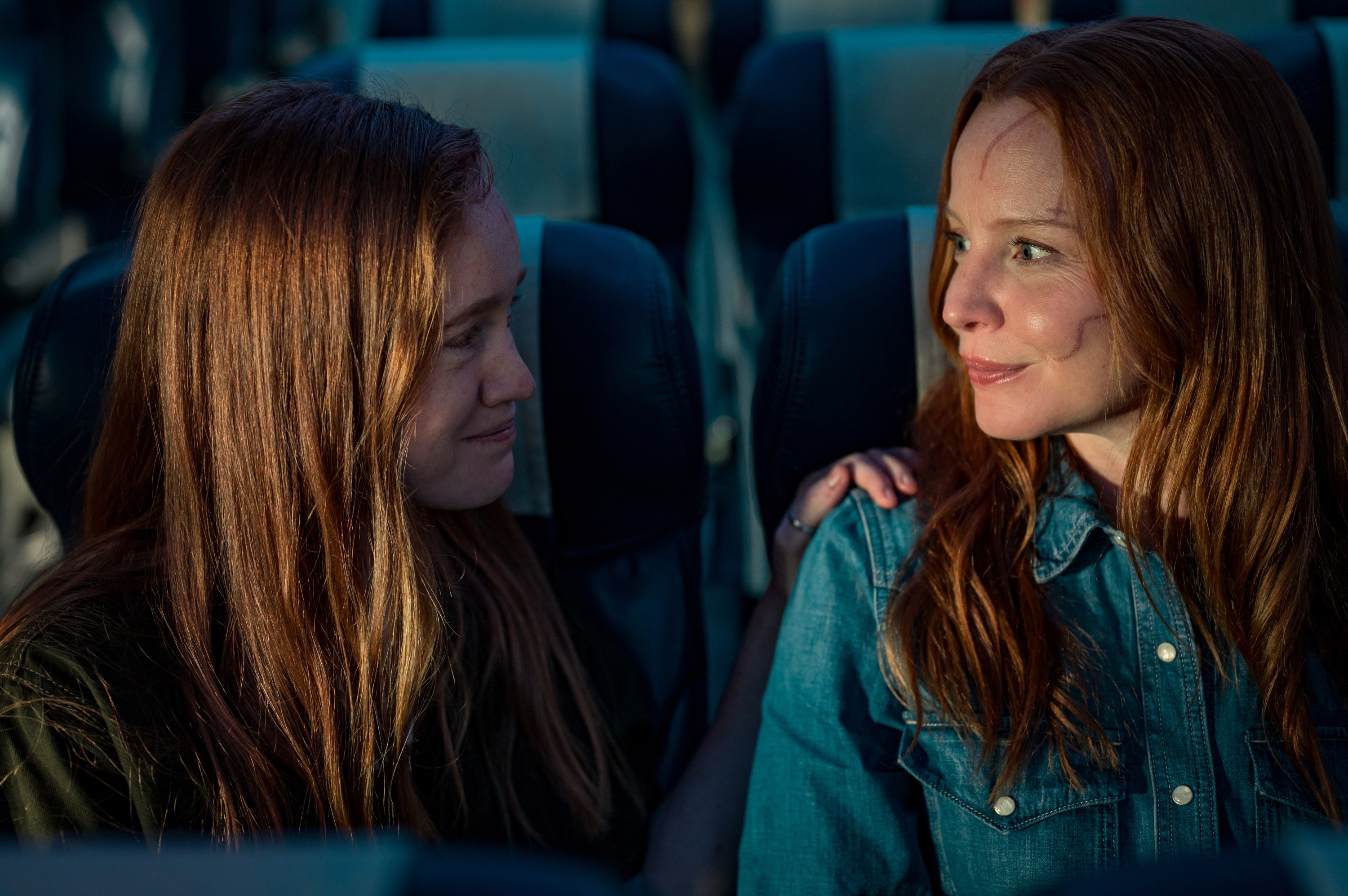
Lauren and Liv spoke to me about their experience of working together on this show and filming their death, and said they both felt like guardians for the character. What questions or scenes did they most want to give input and work out with you?
There was a lot of tonal discussion and back and forth. It’s a collaboration when you’re working with performers. For Liv in particular, their idea of what that final ride on the plane was going to be was an emotional one. I played devil’s advocate and said, “I don’t know if you’re really here. You think you’re here because you’re playing this part, but are you some sort of manifestation of adult Van’s consciousness? Should you just be a sounding board for what she’s going through?” She’s saying, “Why the hell did I go on this journey anyway?” And the reaction is, “Well, because that wasn’t the purpose. You living wasn’t the purpose. You saving a life [Tai] was the purpose.”
There was a conversation and a back and forth and a discussion, and I think we found something that really touched on all of it. It allowed for emotion to play, but also allowed for us to question whether they were really in this space having a conversation with each other.
What occurs to me just now, for the first time ever, is that at the end of The Goonies, you have this moment where they don’t get the ship. That was the whole point — to get the ship. That’s where the money was. And then somebody finds in a pocket or something all the money they need for it. I guess an interesting parallel is that the ship had nothing to do with it. Saving their community was the purpose and they did it. So for Van, her life wasn’t the purpose. It was saving Taissa.
We’ve seen this plane before. When Lottie died, we didn’t get to see Simone and Courtney Eaton on a plane. But when Natalie died, we did see Juliette Lewis and Sophie Thatcher on the plane together.
I had this conversation the other day [about Lottie]. We weren’t present for Lottie’s death. As an audience, we didn’t get to experience it. For Nat, we were experiencing it in real time. She dies and then we go into that space with her, and same with Van. But I do feel cheated as a viewer for not seeing [the Lotties on the plane].
I hope people understand what was on Van’s plane. There are three lights with the projector. Back in the ‘80s, you’d fly on these planes with a giant projector on the ceiling with three lights that were three different colors projecting the image on the wall that they’re watching. So it was about establishing period. Maybe there was no need to see anything like that in Nat’s experience, because this plane isn’t real, right? It’s some sort of interpretation of the way they’re getting from one plane of existence to another. That’s my interpretation, at least. I don’t think she’s going to be on that plane for the rest of eternity. And so I think some of our own personality has to go into that. If the common denominator is that they all take a plane, well, maybe each of their planes looks a little different. Van being a pop culture and movie buff, I thought something connected to that was really important.
Van’s final look after she hears the wisdom from her younger self looked like one of amazement. Can you tell us… what’s coming next after death!? Play god for a moment.
(Laughs) Here’s the thing, what’s great about Yellowjackets, also as a fan of the show, is that you can never predict what’s coming. That’s really what her final look is about for me, “Whoa, okay, so what’s next then? If there’s something that’s going to play out that has a broader significance than just me surviving, what is it?” And honestly, I have no idea what’s coming.
So basically, keep watching Yellowjackets and we’ll find out.
Yeah, exactly.
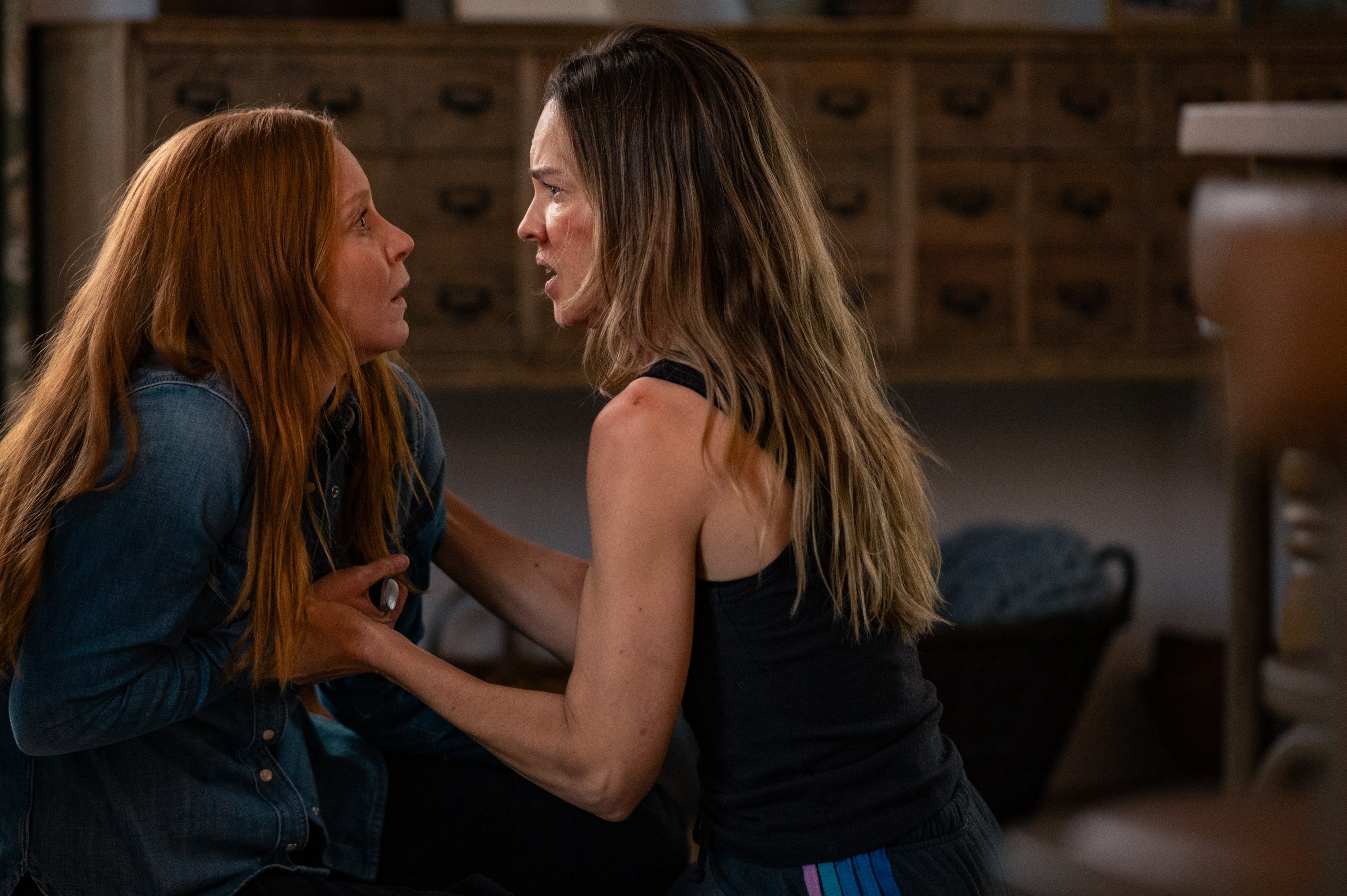
Before that plane, you directed Hilary Swank driving a knife into Lauren Ambrose’s heart. Melissa as a character is exciting to come back into this world and her choice to kill Van comes after she has this switch, after all the changes she had made in her life. What was it like filming that and how do you explain her trauma being triggered?
I love everybody coming up with their own [ideas]. I’m a fan of storytelling that doesn’t offer too many answers. But the backstory that I worked off of and developed throughout was that Adult Melissa came out of the wilderness and instantly recognized that she needed to separate herself from that life. She fakes her death, she goes on to live this weird life where she’s married to the daughter of Hanna [Ashley Sutton], who we know had not survived the wilderness.
I think what happens is that Melissa bottles all this stuff up and at some point realizes there’s this massive void in her life. The danger and excitement of the wilderness is gone, and in order to bring it back and maybe not knowing exactly how it’s going to play out, she pokes the bear. She sends the tape and note to Shauna [Melanie Lynskey] and says, “Let’s see what happens?” I don’t think there was a grand scheme, but I think the two characters of Shauna and Melissa are quite similar. They are both mothers and caregivers for their family.
I came in after they established a lot of Melissa’s home in episode eight, so I was a little limited in the things I could add. One of the things I picked was Melissa’s minivan when she gets away. I wanted that to parallel the two characters as living similar, essentially, boring lives. Melissa is all about trying to recapture something and initially not knowing what that was, and then she’s faced with this moment where she was potentially about to be killed. In the wilderness, when somebody’s standing over you with a knife and they don’t do it, you take the opportunity to do it. I don’t think you go, “Well, I’m glad that we’re friends again.” In the wilderness they learned to be savages and play by a different set of rules.
I’m excited to see what happens with her character. She gets away and I’m excited to see what comes from that. It was a lot of fun working with Hilary and, like my experience with Lauren, trying to figure out who that character was and what made her tick.
The last scene of Lauren’s that you filmed was on the plane. But after you filmed her death scene, was there an emotional moment after “cut” with her co-stars?
I wish I could say that we all stood around and cried. But they were gone. The scene is followed by Shauna and Taissa [Tawny Cypress] coming back in and finding Van’s body, but we shot that separately. [So Lauren’s last scene with Tawny was giving her the oxygen] and it was really beautiful. Of course, after the airplane scene, we had a really nice gathering before wrap and everybody shared stories and shed tears. Rightfully so, it was an opportunity for Liv and Lauren to hug [and take a bow together].
Before Taissa is saved by Van, she has this dream fight with “Other Tai.” All of these adults have trauma they bury, but Tai is the only one who has this alter ego who steps in when it’s too much to bear. Tell me about that fight: does Good Tai win when she opens her eyes? Is Bad Tai gone now?
That dream sequence was collapsed quite a bit for time’s sake. In the dream sequence what was originally scripted, Good Tai was trying to extinguish Bad Tai. When Tai wakes up with the oxygen being applied to her face and says, “She’s gone,” she’s saying that she’s vanquished Bad Tai, that she’s been operating under Bad Tai for the balance of the season. I feel like from the onset of the season, Bad Tai was present. If the dream sequence had played out a little bit longer, maybe we would have gotten a stronger sense of that. But I think Bad Tai loves Van, no matter what. I think they both care for Van. The question is in their execution; the actions they take to support her are different.
This episode also featured the Shauna-Melissa arm bite, and the arm eating is the most gory cannibalism scene we’ve seen since the Jackie feast that you directed, where a lot of the cast spoke to me about actually gagging when filming. Are you the go-to Yellowjackets cannibalism director now?
(Laughs) I guess so! I never thought about it. The “Jackie-fruit” [the cast nickname for what Jackie’s body was made out of, jackfruit] was very intense. I don’t think much has compared to that sequence. In reality, gagging — those poor girls! They were troopers. We had a really wonderful experience between me, Jonathan, Bart, Ashley and the entire team. I really wanted to come back and do more this season. I was just unfortunately not available. I was doing another show called Black Rabbit for Netflix, which I’m pretty excited about. When my availability became limited, I think they wanted to put me in an episode where I was doing something big, because “Edible Complex” and “Where the Story Ends” are big episodes in terms of trying to manage all these different storylines and give them all the amount of attention and thought they require.
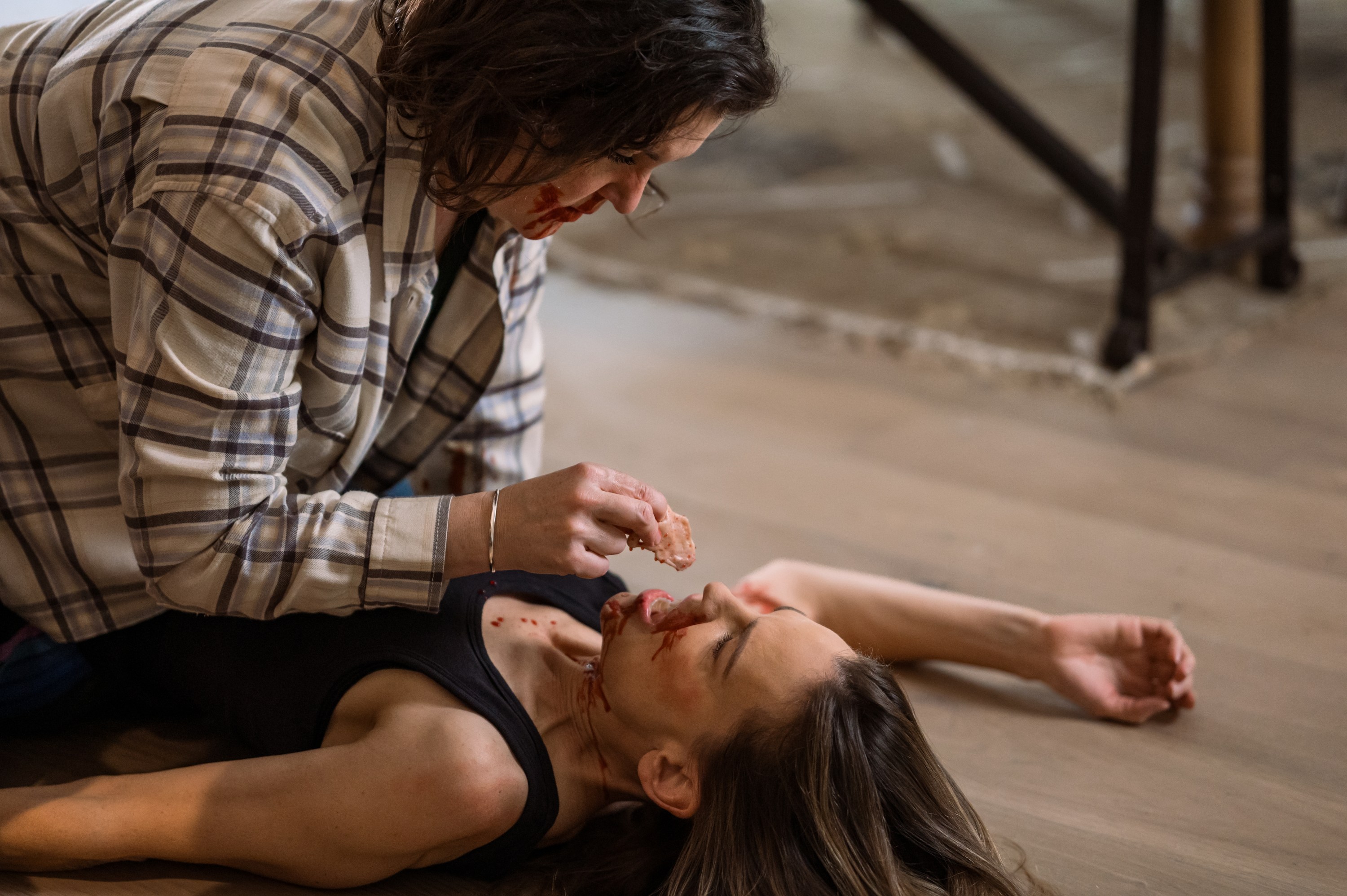
Hilary Swank told me that she and Melanie Lynskey did their own stunts for their fight sequence.
They were both great and yes, they both did, I think, all of the stunts. I think we brought a stunt person in for a second pass at the throwing of the jar of jam, and Melanie’s throw was better. I wanted to make sure that the fight felt real, and I think it did. I didn’t want it to feel like stunt people. I wanted it to feel like two real women who are in their prime wrestling, fighting, pulling hair, stumbling out, throwing a jar. When they both agreed to do the majority of the stunts, that really elevated the scenes.
Co-showrunner and director Jonathan Lisco would have neuroscientific answer for what eating your own flesh does to your brain… do you think that when Melissa is forced by Shauna to eat her own skin that it sends her into trigger mode?
That’s so interesting because just as you said that, I started thinking of that same thing. Yes and, was the moment it was dangled above her face the moment she realized, “This was what I wanted this whole time”? Because there’s a complacency to the way she eats it, right? At first Melissa is struggling [eating the piece of her arm] and then you think, boy, she’s enjoying this. Hilary does a great job of selling that moment because even after rewatching it, it really looks like she’s digging it! So it was definitely a shock when she spin it out. But yeah, maybe she’s been a vegetarian this whole time and the proteins triggered something!
There’s another unexpected moment this episode when Hanna kills Joel McHale’s character, Kodiak, by throwing a knife into his eye. (We see what happens to him in the finale). Frog scientist Hanna is such a mysterious character. Is she really drawn to what they are doing out there, or is she playing them for her own survival and to get back to her kid?
We’ve had lots of conversations about this. At first, it seems like she’s weak and frail leading up to my episode and then throughout the episode, she still feels a little weak. In the scene where Mari [Alexa Barajas] and Nat [Thatcher] are leading her into the woods, she still feels nervous and weak. So, what’s the switch? Is she so enamored by these teenagers?
There’s also a misdirect earlier when she’s talking to Melissa [Jenna Burgess] in the cage and she says, “Studying you guys is way more interesting than studying frogs.” Initially, I thought maybe she was just signing up for this. But I don’t think that’s what she’s doing. I think as a mother, she knows that this guy, Kodi, is not going to be their savior. He’s not going to mesh with these teenage girls, that’s not the way out. I think she knows if there’s any chance she’s going to get back, she needs to endear herself to these teenagers. And, how do you do that? You look at what the leader would do, and you do what the leader would do.
I think that’s what happens here. She’s faced with this decision. This guy using this real vulgar language behind her [when he calls her the C-word], and showing his true colors, and this teenage feral leader [Shauna, played by Sophie Nélisse] with a gun on her. I think she says to herself: As a mother, if I’m ever going to get back, I need to show her that I can be part of the tribe. And she turns around and just pops him right in the eye.
So you think she’s a lot smarter than we give her credit for.
Exactly. And I’m really excited to see what comes with the Hanna story.
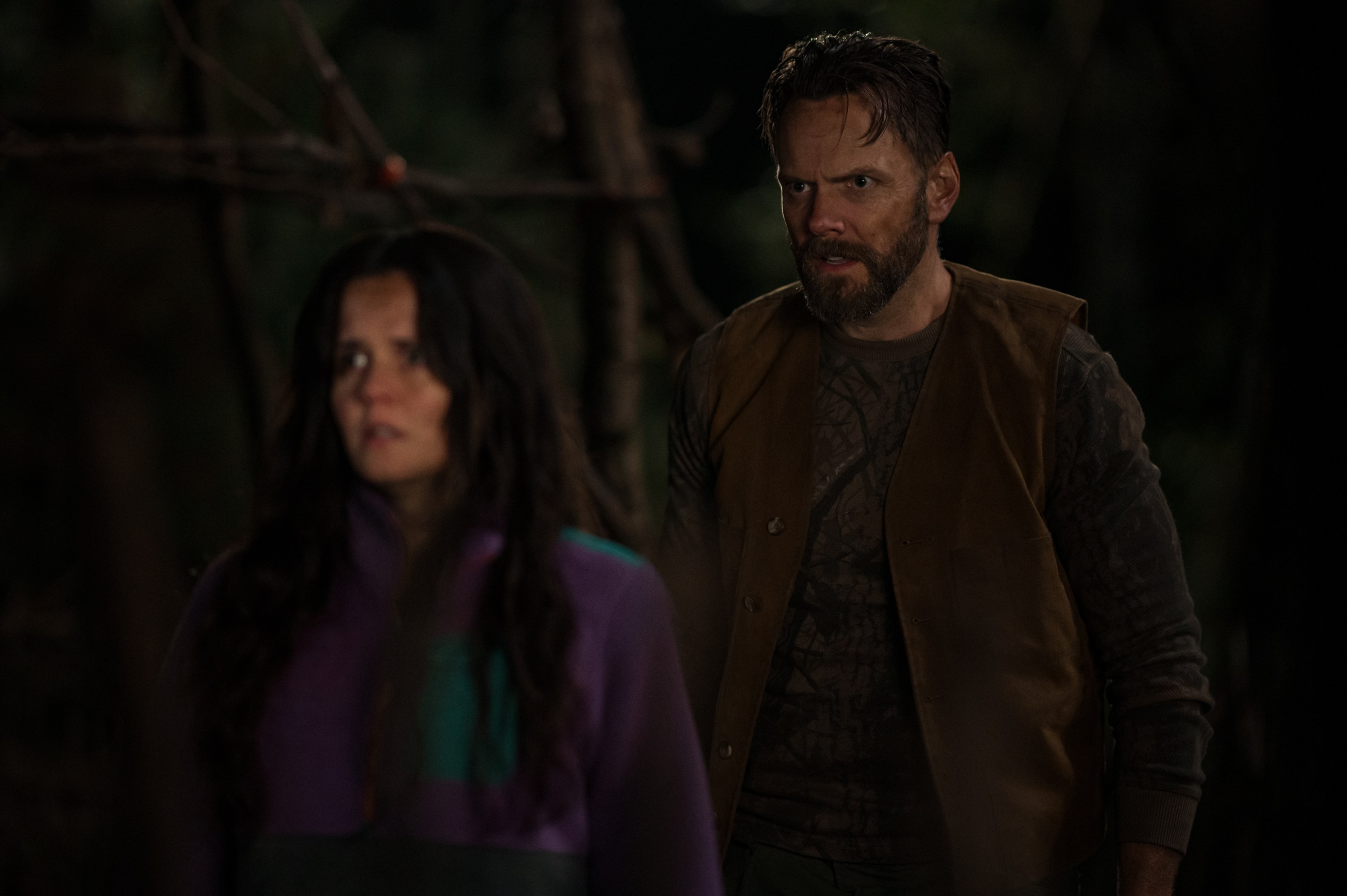
The division between who wants to be rescued and who wants to stay in the wilderness also gets bigger. Teen Nat (Thatcher) is the most destroyed when their plan fails, which is interesting because she came to the woods from a home that you assume she would never want to return to. How has the wilderness changed Nat and why did you want to leave us on that note of her crying as snow is falling down, signifying that another winter is coming?
Well, she’s a survivor. Look, I had a great childhood. I was surrounded by love. But I think people who are in those situations with families that are abusive and they make it out, they make it out because they love life. They want to live and they don’t want to be under the thumb of abuse anymore. I think that’s why she cares so much about getting back. She managed to survive that abuse, yet this is what’s going to kill her? Being trapped out in the woods, and we had this opportunity to get home? I think she feels helpless that she’s yet again trapped in a situation, but this time doesn’t have the means to escape. She knows what’s coming and then, of course, she’s right. Here’s winter and the horror that was the last winter is coming.
We also see Travis (Kevin Alves) building this pit, which continues this season three origin story of the infamous “Pit Girl” scene that opened the whole series. How tricky was this scene to figure out when like you said, Lottie essentially walks on water?
What’s great about filmmaking is that it’s this beautiful synergy between storytelling and imagery and sound. They are all very important. There’s an interplay. My question to you is, when did you know that was the pit?
It took me a minute before I recognized it as the pit that Mari fell into in the beginning of the season because of Coach (Steven Krueger). So Travis found that pit, and reconstructed it?
In the woods, it’s tough to give people landmarks that tell you, “Hey, you’re in the exact same place you’ve been before.” But yes, he is supplementing to that pit. And what’s great about moments like this is that you start to dig into the mythology. You discuss, “How tall are the spikes? In that opening scene, was there a foot of snow in the bottom of the pit? Was there two feet of snow?” It’s a question of, how do you reveal something? How do you give people that satisfaction?
We wanted to see Travis building something. What is this trap? At first you don’t know. He’s just weaving this thicket together. For me, the most important thing is to save that moment of the sticks and make it a powerful moment. Looking down into the pit is not a powerful moment — looking up at this teenager that is desperate to get out of the wilderness and kill this false prophet in Lottie is powerful. Standing over it and revealing the ends of this spikes, for me, was very powerful and yet a very difficult shot to achieve.
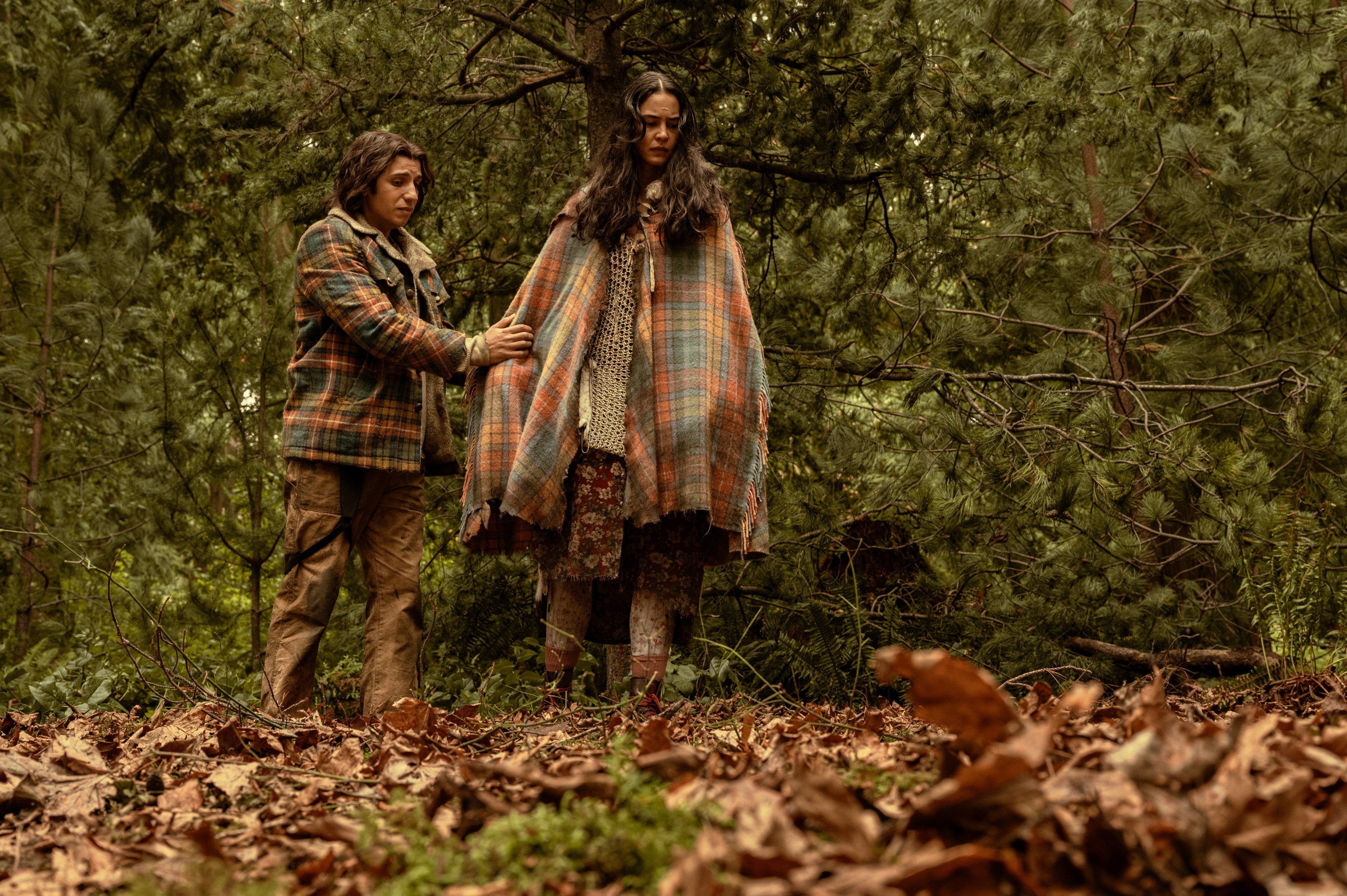
So Travis did really want to kill Lottie, and then fate had other plans?
Yes. It was the only way out of the situation. I think he feels she was torturing him a bit. He puts her onto Akilah [Nia Sondaya] as a means of getting out from underneath that torture. “Look, Akila has a better connection to the wilderness than I do.” Then he realizes that diversion wasn’t enough, because now Lottie is standing in the way of their escape. This false prophet is telling everybody they need to stay in the woods. And so I think he really wanted to kill her. I think the thing that stops him is that she apologizes and genuinely tries to explain her motives to him, which were, “I was just trying to help you grieve and get through your loss of your brother and your father and know that they’re still here.”
Having just lost my father, grief is tough. I think Travis receiving that apology from Lottie was the thing that made him realize, “Oh, I don’t need to go through this plan.” But then it gets out of his control and faith, spirit… maybe he just built it again too strong? I don’t know what the reason is, but she doesn’t die.
It’s always a shame, the consolidation of episodes. They write such great, beautiful episodes and there tends to be more meat on their bone — pun intended! — and we always have to do a little bit of consolidating of story. There was a scene where Travis was sitting getting drunk and he had that log in his hand, and he was staring at the pit deciding, “Do I chuck this or do I believe in this hocus pocus?”
The biggest question in this show is about that mythology of the wilderness vs. explainable trauma. I think we’ve gotten a lot answered this season leaning towards the latter. After directing this pivotal episode, where do you land?
It’s completely unanswered. But that’s my take. I think that’s the basis of faith and belief. To harken back on this experience of my father passing, you’re constantly looking to give yourself some comfort, right? Some means to understand things that are uncontrollable. I think the teenagers needed to explain everything that happened out there in the wilderness somehow. They needed to justify these awful things they did to survive. So, what do they do? You don’t say, “Well, we need to survive. So we’re gonna eat each other.” They say, “It wants us to. We did survive and we fed it, so there must be an it.”
But nobody can prove it. Nobody can put their finger on it. It continues to haunt them throughout their lives when they’re trying to explain other things. I think that’s what’s beautiful about the show. Maybe Jonathan, Ashley and Bart have a plan to answer “it” and say “it is this,” but I personally think not knowing the truth is better. Maybe the audience doesn’t.
I worked on The Leftovers years ago with Damon Lindelof. He comes, obviously, from Lost, which was unanswered to some extent, or I guess they tried to answer it and was not a real well-received answer. I think as mad as you get about not knowing the answer, you have to believe in something, or life sometimes is too hard to navigate. Is there an “it” that’s protecting us? Are my actions justified?
Looking ahead to the finale, we see that Misty (Christina Ricci) gets the answer to who killed Lottie at the end of the penultimate episode, but the audience doesn’t know yet. How would you say all of the threads in this episode lead to a wild ending for season three?
Our goal this episode was ending certain stories in climactic ways, yet building a platform for the show to leap off. Sometimes directors get frustrated when they feel like they’re building that platform. But if I can entertain you while I’m building, that’s pretty exciting. I think we do a good job of that for the audience in describing the relationships that are then going to get blown up [in the finale]. All of the finale was a bit of a shock and kept very close to the vest throughout. There was a moment when I was directing this episode where I had to lean over to somebody, maybe it was Ashley, and just go, “I think I need to know what happens.” They told me and I went, “No!”
***
Yellowjackets releases its season three finale on Friday, with a linear airing Sunday at 8 p.m. on Showtime. Follow along with all of THR‘s season coverage and interviews, including our postmortem with Lauren Ambrose and Liv Hewson.
Source: Hollywoodreporter
HiCelebNews online magazine publishes interesting content every day in the TV section of the entertainment category. Follow us to read the latest news.
Related Posts
- Jenna Ortega Reveals the Real Reasons Behind Her Departure from the ‘Scream’ Franchise
- The Minecraft Movie Takes the Spotlight: Is a Roblox Film on the Horizon?
- Weezer to Take the Stage at Coachella Amidst Personal Tragedy for Bassist Scott Shriner
- Harry Hamlin Shares Heartfelt Pride for Daughters Delilah and Amelia as They Make Their Mark on the World
- Celebrating Excellence: Michael Feldman, Julie Henderson, and Shannon Ryan to Receive Prestigious Honors at the 2025 Communicator Awards





